Case Study: Contract and Negligence in Business Law - HA2022
VerifiedAdded on 2023/04/25
|12
|1078
|321
Case Study
AI Summary
This case study solution addresses two primary legal issues: contract law, specifically misrepresentation, and negligence. The contract issue examines whether a legal issue arises from a situation involving Sunnybank Pty Ltd and John Gravatt, focusing on potential misrepresentation in their contract. It applies contract law principles to determine if Sunnybank's silence constitutes misrepresentation and what remedies are available to John Gravatt. The negligence issue assesses Henrietta's claim against a firm for mental distress caused by an incompetent clerk. It analyzes whether the firm owed Henrietta a duty of care, whether that duty was breached, and whether the breach caused her emotional distress, referencing relevant case law to support the conclusion that Henrietta has a valid claim under negligence. Desklib offers similar solved assignments and past papers for students.

BUSINESS LAW
CONTRACT AND NEGLIGENCE
CONTRACT AND NEGLIGENCE
Paraphrase This Document
Need a fresh take? Get an instant paraphrase of this document with our AI Paraphraser
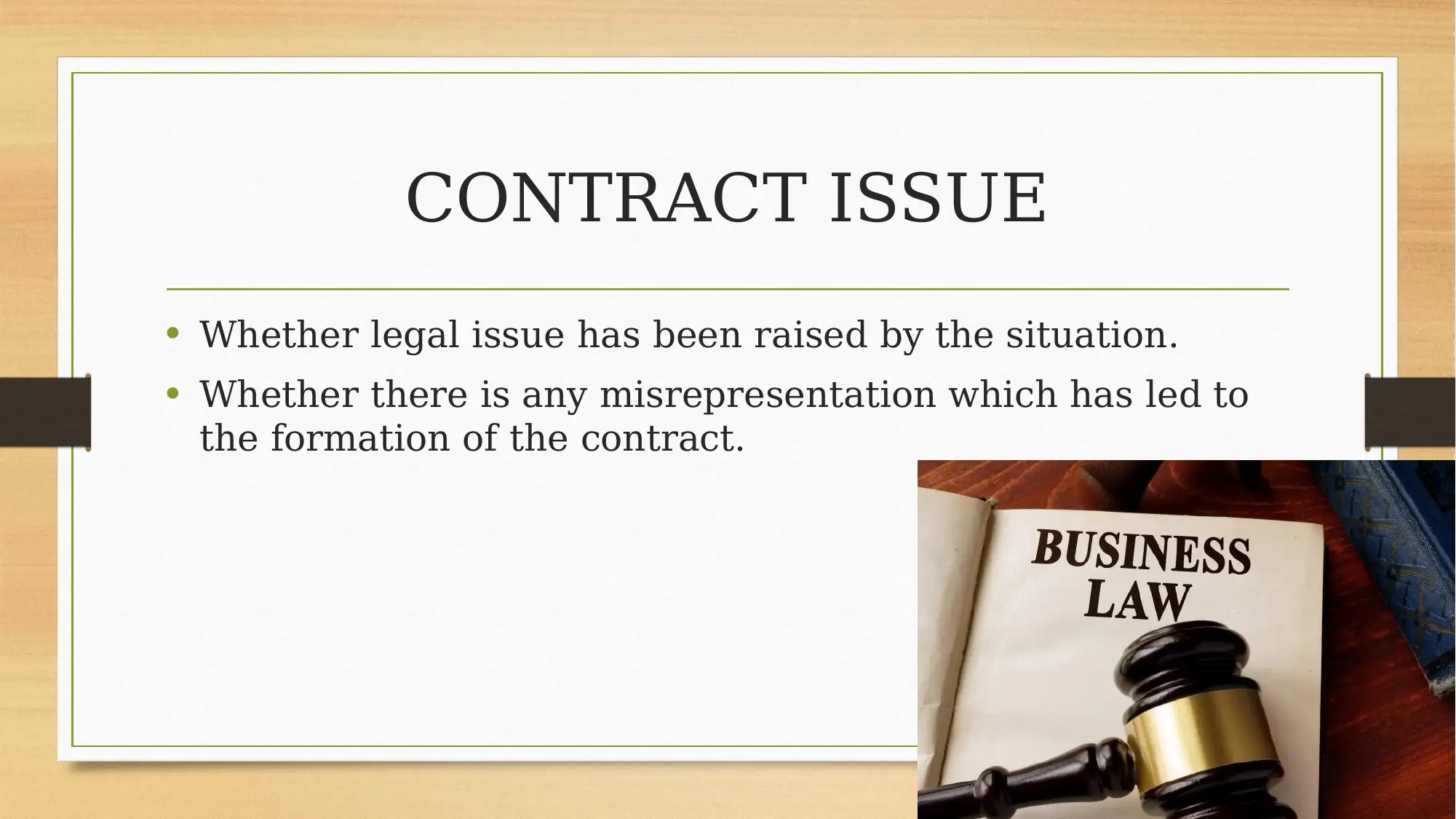
CONTRACT ISSUE
• Whether legal issue has been raised by the situation.
• Whether there is any misrepresentation which has led to
the formation of the contract.
• Whether legal issue has been raised by the situation.
• Whether there is any misrepresentation which has led to
the formation of the contract.
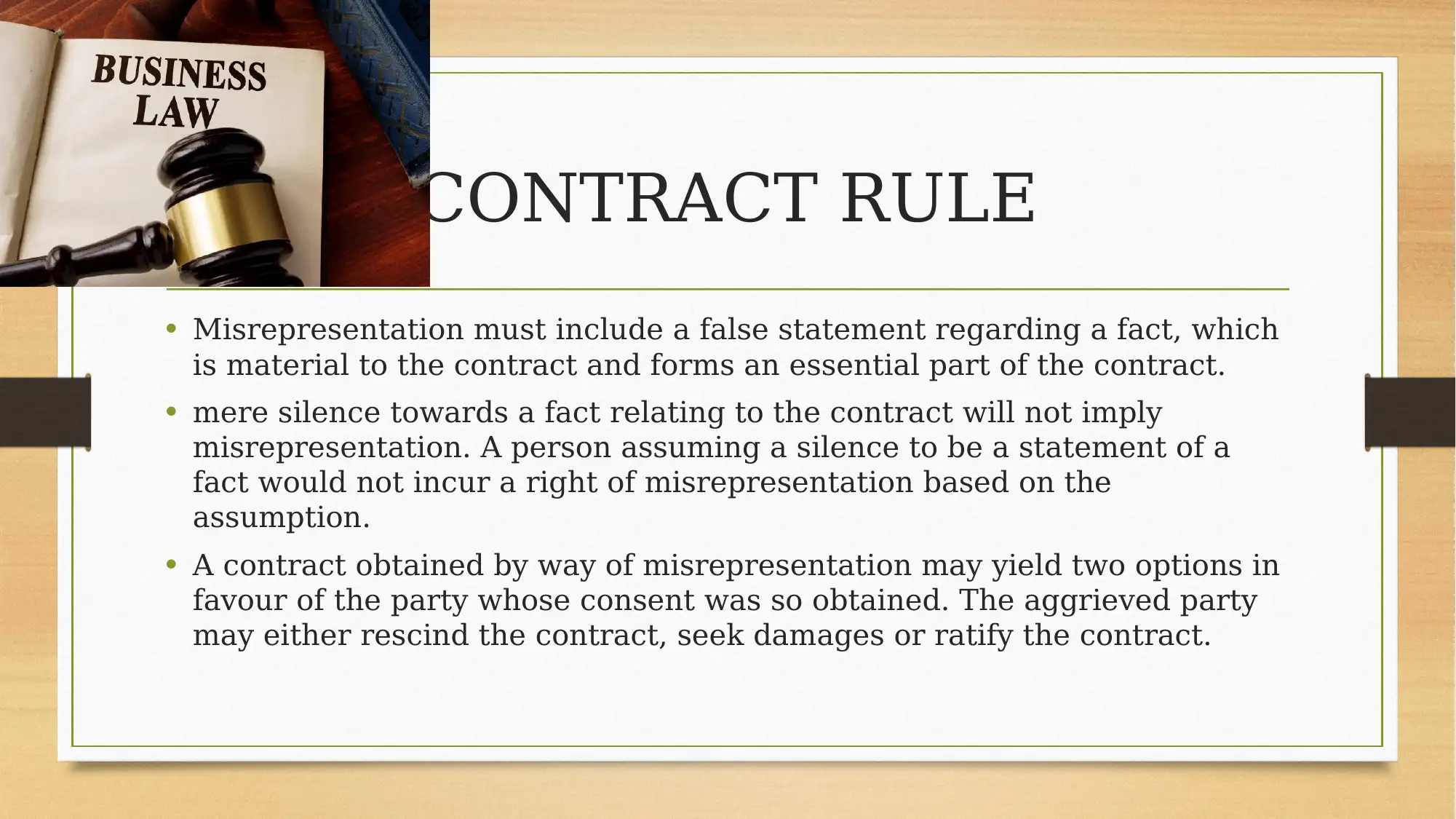
CONTRACT RULE
• Misrepresentation must include a false statement regarding a fact, which
is material to the contract and forms an essential part of the contract.
• mere silence towards a fact relating to the contract will not imply
misrepresentation. A person assuming a silence to be a statement of a
fact would not incur a right of misrepresentation based on the
assumption.
• A contract obtained by way of misrepresentation may yield two options in
favour of the party whose consent was so obtained. The aggrieved party
may either rescind the contract, seek damages or ratify the contract.
• Misrepresentation must include a false statement regarding a fact, which
is material to the contract and forms an essential part of the contract.
• mere silence towards a fact relating to the contract will not imply
misrepresentation. A person assuming a silence to be a statement of a
fact would not incur a right of misrepresentation based on the
assumption.
• A contract obtained by way of misrepresentation may yield two options in
favour of the party whose consent was so obtained. The aggrieved party
may either rescind the contract, seek damages or ratify the contract.
⊘ This is a preview!⊘
Do you want full access?
Subscribe today to unlock all pages.

Trusted by 1+ million students worldwide
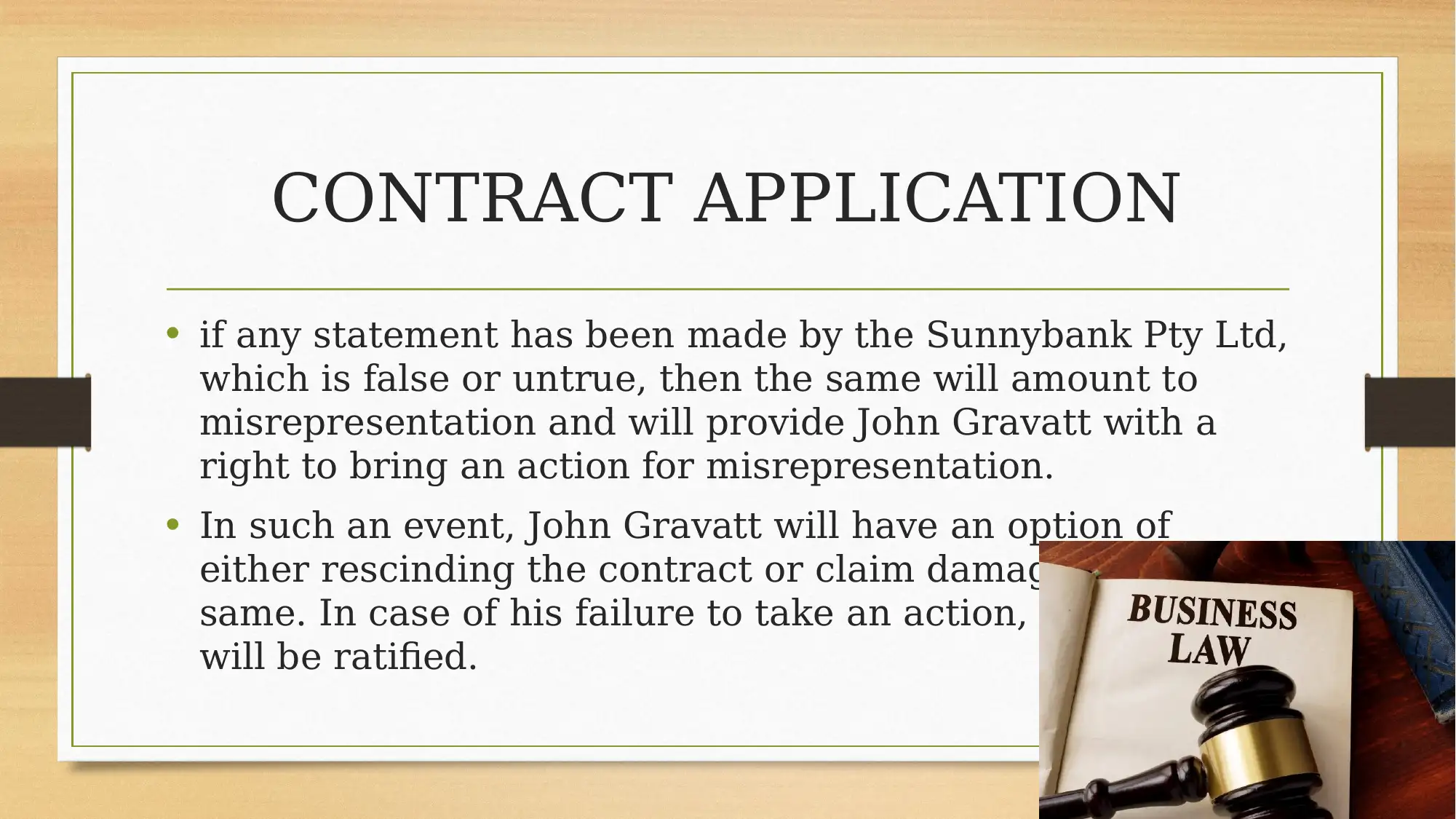
CONTRACT APPLICATION
• if any statement has been made by the Sunnybank Pty Ltd,
which is false or untrue, then the same will amount to
misrepresentation and will provide John Gravatt with a
right to bring an action for misrepresentation.
• In such an event, John Gravatt will have an option of
either rescinding the contract or claim damages for the
same. In case of his failure to take an action, the contract
will be ratified.
• if any statement has been made by the Sunnybank Pty Ltd,
which is false or untrue, then the same will amount to
misrepresentation and will provide John Gravatt with a
right to bring an action for misrepresentation.
• In such an event, John Gravatt will have an option of
either rescinding the contract or claim damages for the
same. In case of his failure to take an action, the contract
will be ratified.
Paraphrase This Document
Need a fresh take? Get an instant paraphrase of this document with our AI Paraphraser
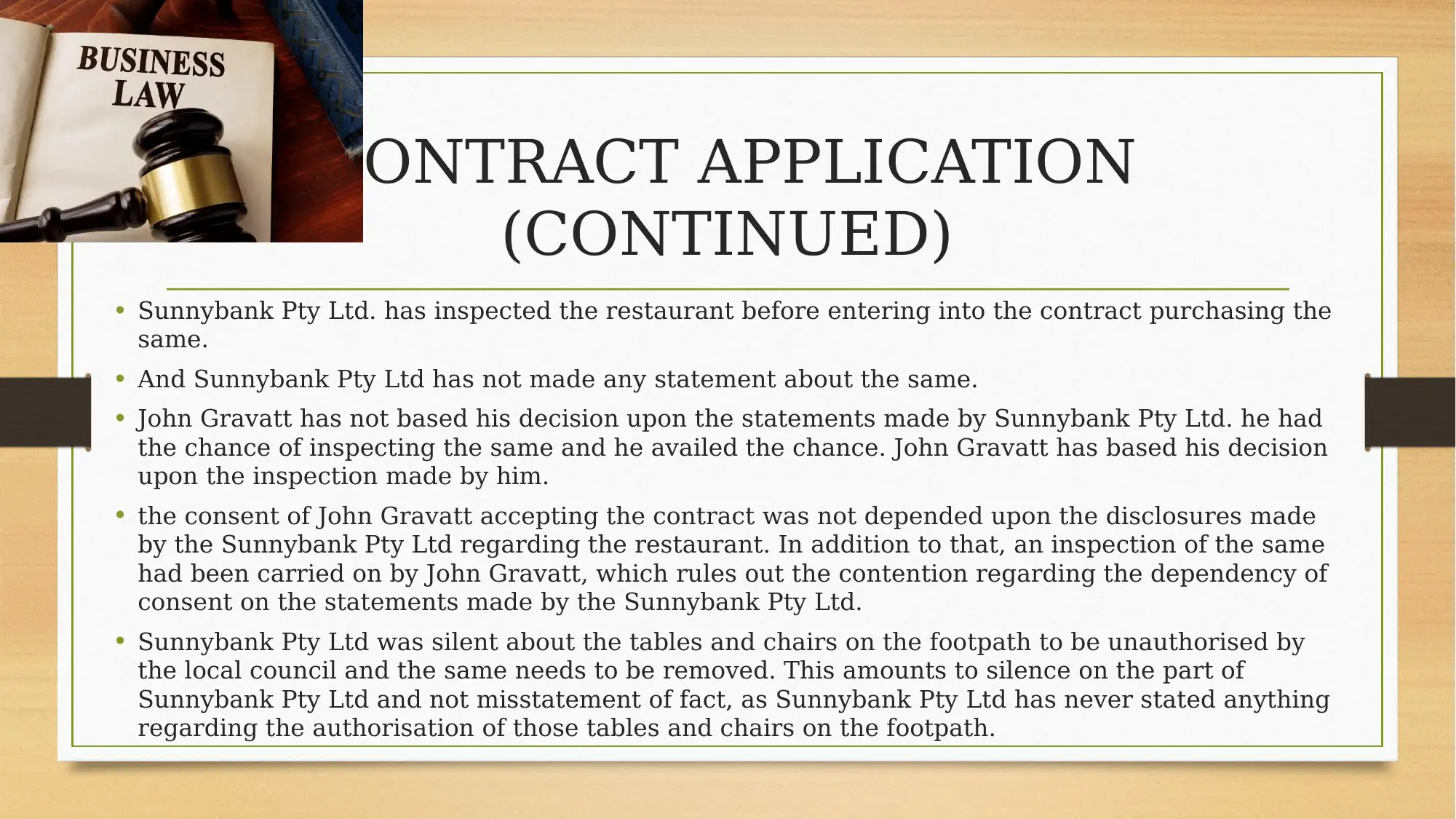
CONTRACT APPLICATION
(CONTINUED)
• Sunnybank Pty Ltd. has inspected the restaurant before entering into the contract purchasing the
same.
• And Sunnybank Pty Ltd has not made any statement about the same.
• John Gravatt has not based his decision upon the statements made by Sunnybank Pty Ltd. he had
the chance of inspecting the same and he availed the chance. John Gravatt has based his decision
upon the inspection made by him.
• the consent of John Gravatt accepting the contract was not depended upon the disclosures made
by the Sunnybank Pty Ltd regarding the restaurant. In addition to that, an inspection of the same
had been carried on by John Gravatt, which rules out the contention regarding the dependency of
consent on the statements made by the Sunnybank Pty Ltd.
• Sunnybank Pty Ltd was silent about the tables and chairs on the footpath to be unauthorised by
the local council and the same needs to be removed. This amounts to silence on the part of
Sunnybank Pty Ltd and not misstatement of fact, as Sunnybank Pty Ltd has never stated anything
regarding the authorisation of those tables and chairs on the footpath.
(CONTINUED)
• Sunnybank Pty Ltd. has inspected the restaurant before entering into the contract purchasing the
same.
• And Sunnybank Pty Ltd has not made any statement about the same.
• John Gravatt has not based his decision upon the statements made by Sunnybank Pty Ltd. he had
the chance of inspecting the same and he availed the chance. John Gravatt has based his decision
upon the inspection made by him.
• the consent of John Gravatt accepting the contract was not depended upon the disclosures made
by the Sunnybank Pty Ltd regarding the restaurant. In addition to that, an inspection of the same
had been carried on by John Gravatt, which rules out the contention regarding the dependency of
consent on the statements made by the Sunnybank Pty Ltd.
• Sunnybank Pty Ltd was silent about the tables and chairs on the footpath to be unauthorised by
the local council and the same needs to be removed. This amounts to silence on the part of
Sunnybank Pty Ltd and not misstatement of fact, as Sunnybank Pty Ltd has never stated anything
regarding the authorisation of those tables and chairs on the footpath.
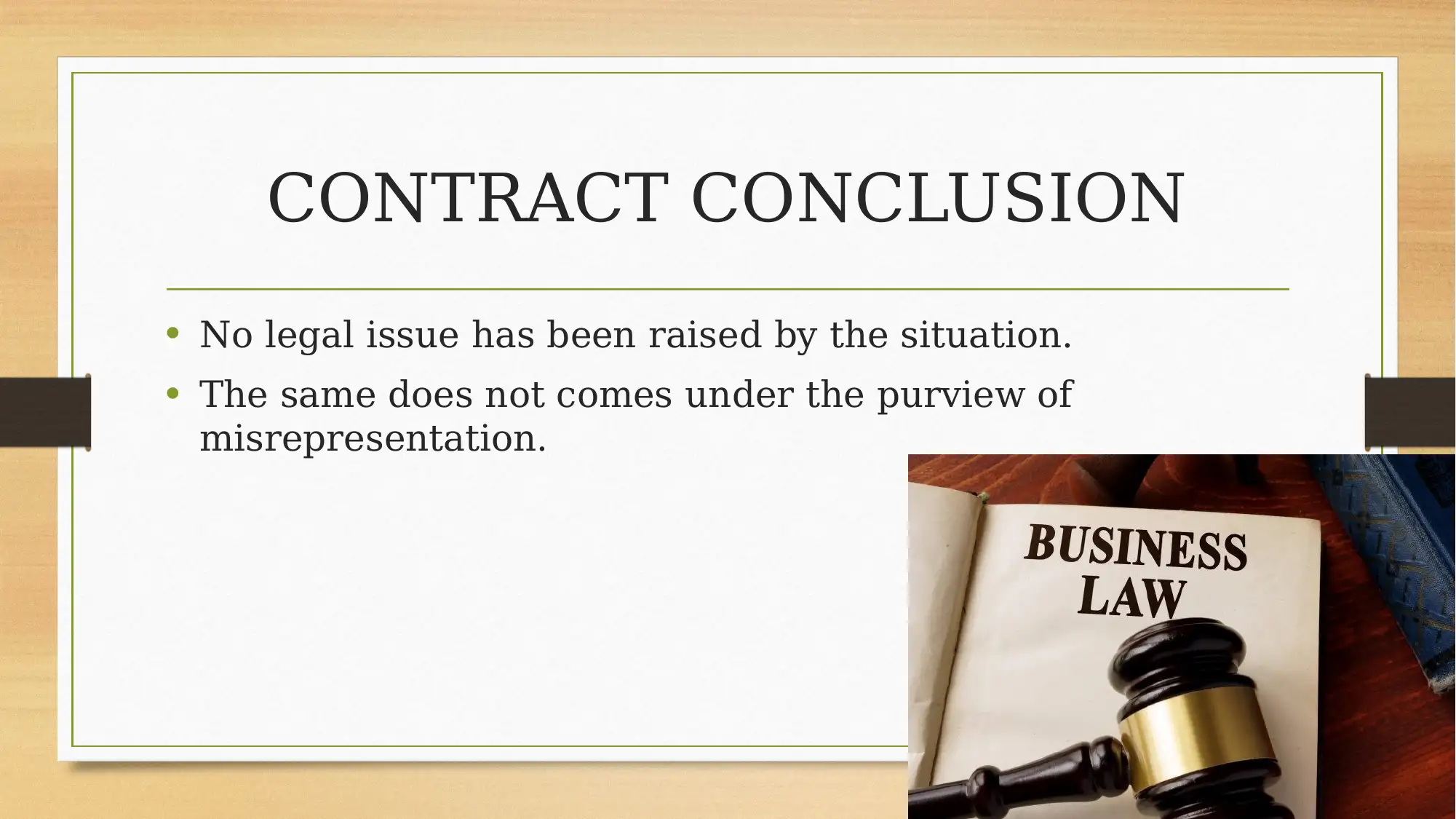
CONTRACT CONCLUSION
• No legal issue has been raised by the situation.
• The same does not comes under the purview of
misrepresentation.
• No legal issue has been raised by the situation.
• The same does not comes under the purview of
misrepresentation.
⊘ This is a preview!⊘
Do you want full access?
Subscribe today to unlock all pages.

Trusted by 1+ million students worldwide
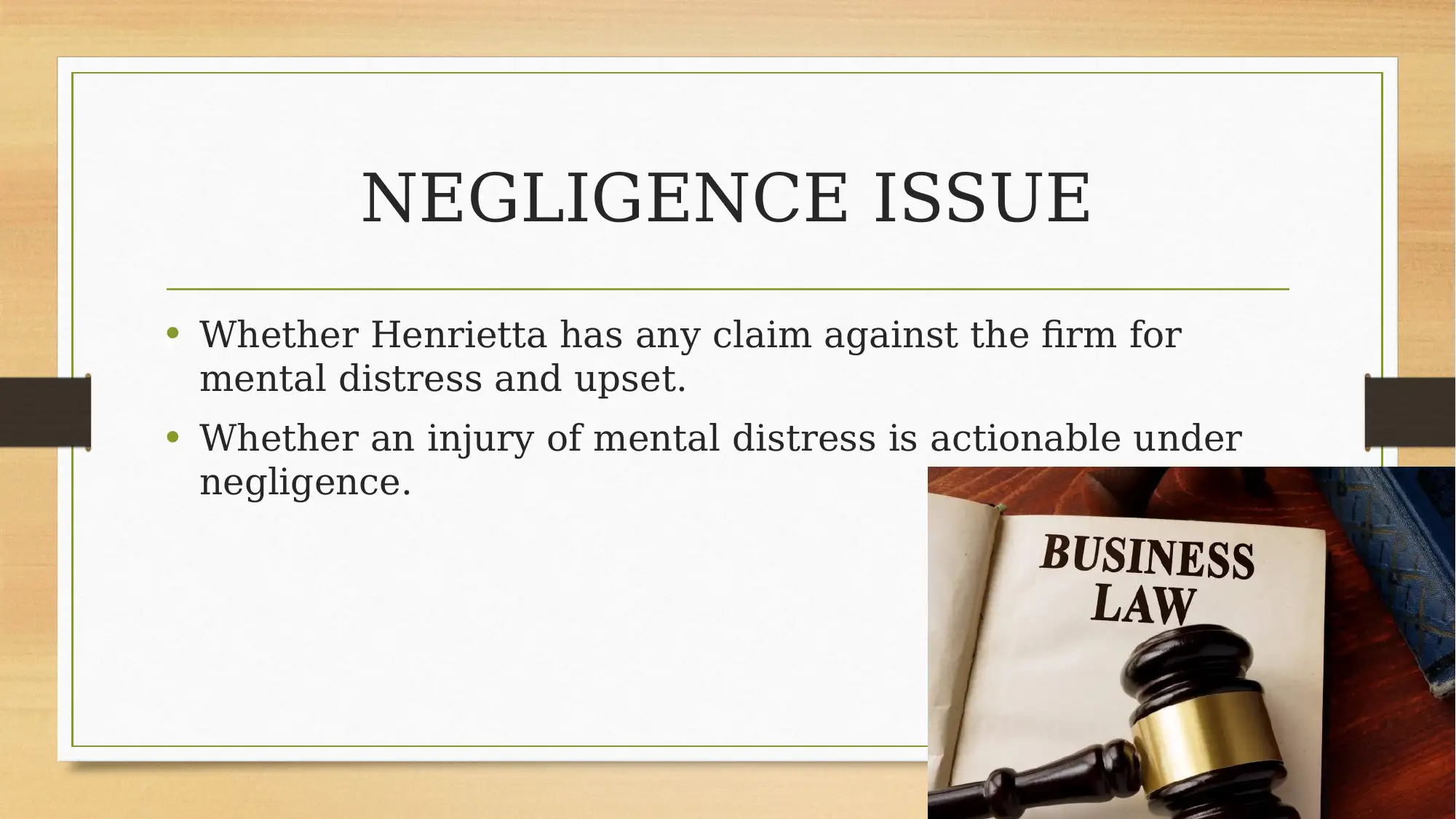
NEGLIGENCE ISSUE
• Whether Henrietta has any claim against the firm for
mental distress and upset.
• Whether an injury of mental distress is actionable under
negligence.
• Whether Henrietta has any claim against the firm for
mental distress and upset.
• Whether an injury of mental distress is actionable under
negligence.
Paraphrase This Document
Need a fresh take? Get an instant paraphrase of this document with our AI Paraphraser
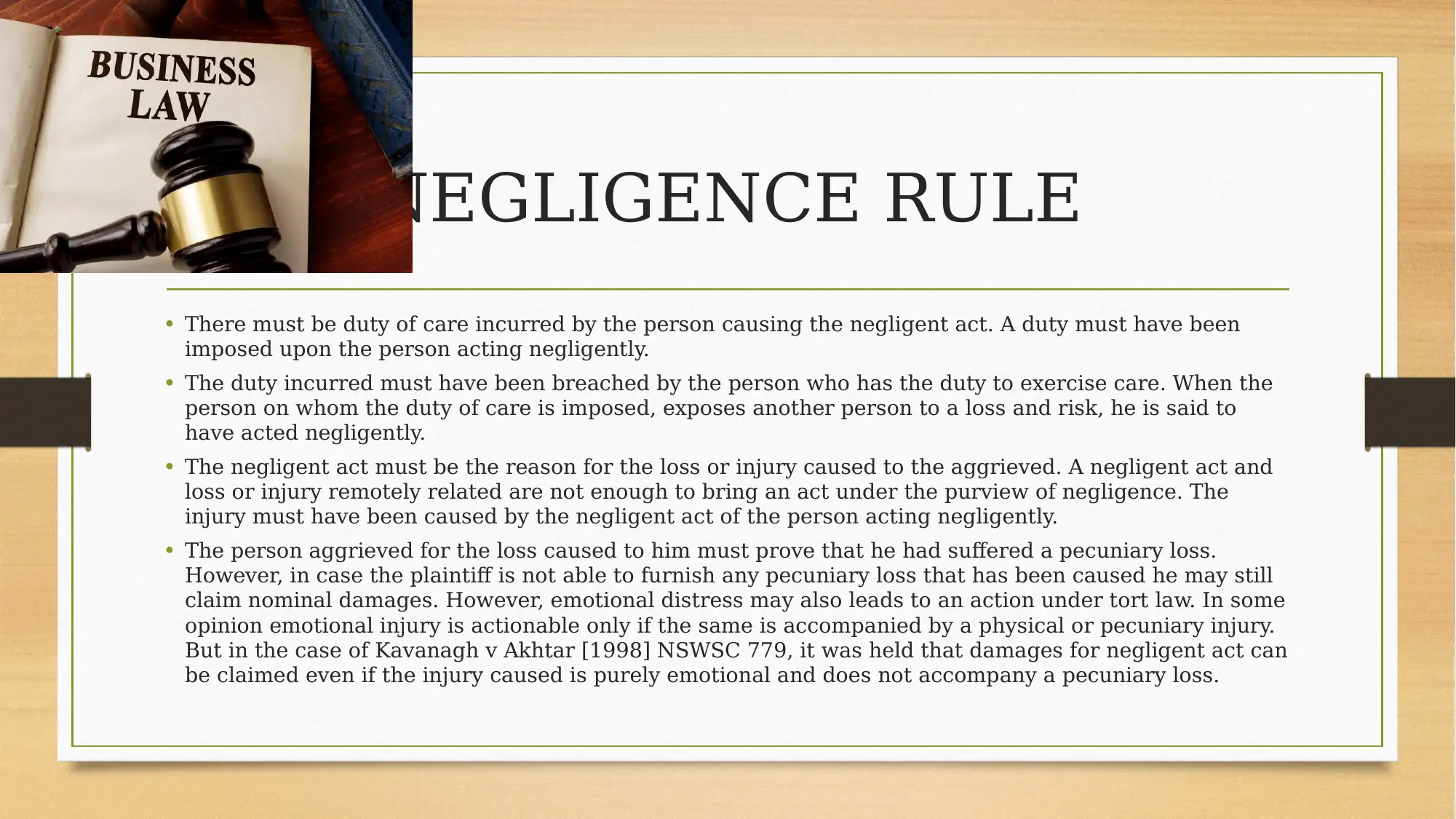
NEGLIGENCE RULE
• There must be duty of care incurred by the person causing the negligent act. A duty must have been
imposed upon the person acting negligently.
• The duty incurred must have been breached by the person who has the duty to exercise care. When the
person on whom the duty of care is imposed, exposes another person to a loss and risk, he is said to
have acted negligently.
• The negligent act must be the reason for the loss or injury caused to the aggrieved. A negligent act and
loss or injury remotely related are not enough to bring an act under the purview of negligence. The
injury must have been caused by the negligent act of the person acting negligently.
• The person aggrieved for the loss caused to him must prove that he had suffered a pecuniary loss.
However, in case the plaintiff is not able to furnish any pecuniary loss that has been caused he may still
claim nominal damages. However, emotional distress may also leads to an action under tort law. In some
opinion emotional injury is actionable only if the same is accompanied by a physical or pecuniary injury.
But in the case of Kavanagh v Akhtar [1998] NSWSC 779, it was held that damages for negligent act can
be claimed even if the injury caused is purely emotional and does not accompany a pecuniary loss.
• There must be duty of care incurred by the person causing the negligent act. A duty must have been
imposed upon the person acting negligently.
• The duty incurred must have been breached by the person who has the duty to exercise care. When the
person on whom the duty of care is imposed, exposes another person to a loss and risk, he is said to
have acted negligently.
• The negligent act must be the reason for the loss or injury caused to the aggrieved. A negligent act and
loss or injury remotely related are not enough to bring an act under the purview of negligence. The
injury must have been caused by the negligent act of the person acting negligently.
• The person aggrieved for the loss caused to him must prove that he had suffered a pecuniary loss.
However, in case the plaintiff is not able to furnish any pecuniary loss that has been caused he may still
claim nominal damages. However, emotional distress may also leads to an action under tort law. In some
opinion emotional injury is actionable only if the same is accompanied by a physical or pecuniary injury.
But in the case of Kavanagh v Akhtar [1998] NSWSC 779, it was held that damages for negligent act can
be claimed even if the injury caused is purely emotional and does not accompany a pecuniary loss.
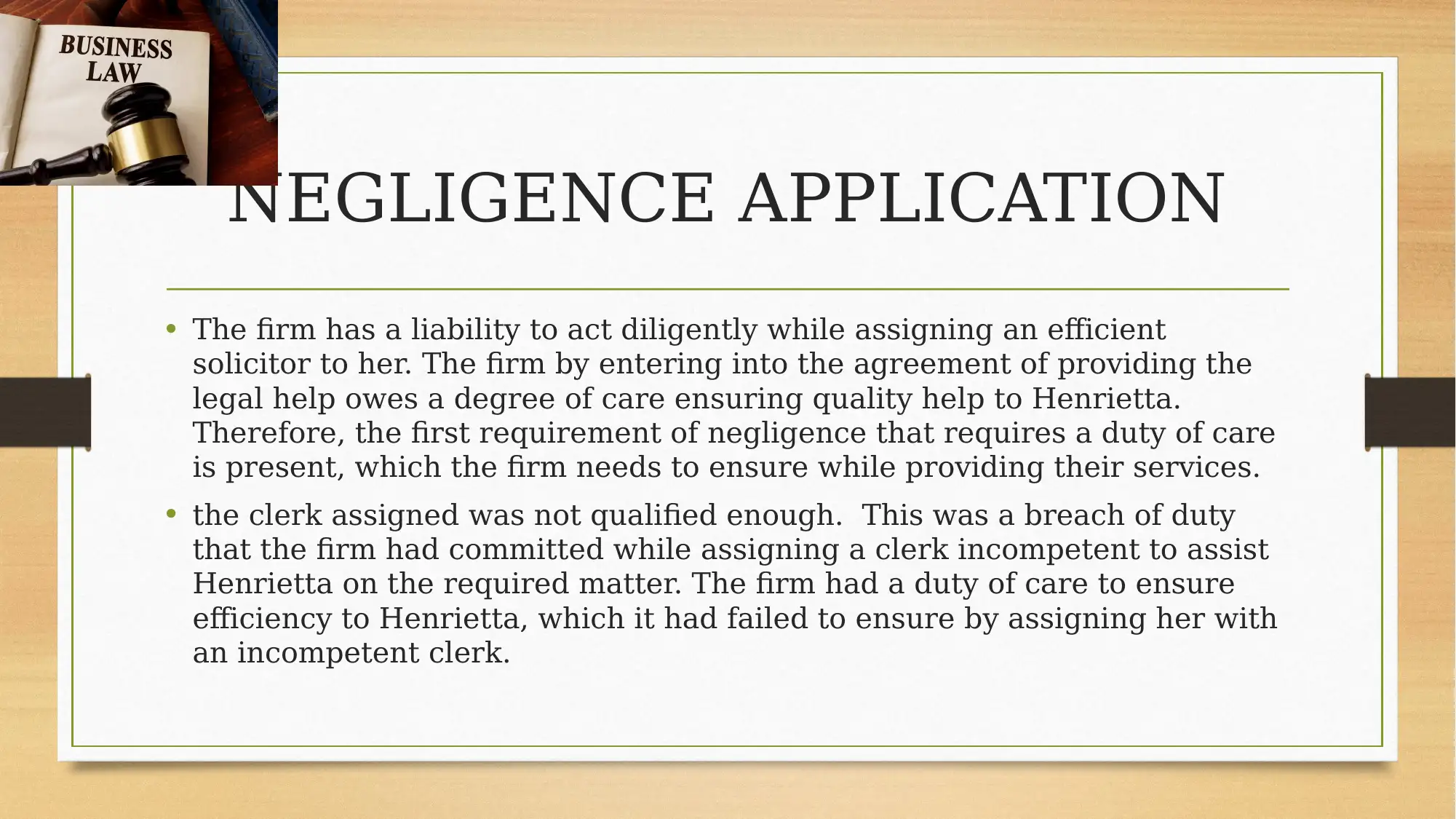
NEGLIGENCE APPLICATION
• The firm has a liability to act diligently while assigning an efficient
solicitor to her. The firm by entering into the agreement of providing the
legal help owes a degree of care ensuring quality help to Henrietta.
Therefore, the first requirement of negligence that requires a duty of care
is present, which the firm needs to ensure while providing their services.
• the clerk assigned was not qualified enough. This was a breach of duty
that the firm had committed while assigning a clerk incompetent to assist
Henrietta on the required matter. The firm had a duty of care to ensure
efficiency to Henrietta, which it had failed to ensure by assigning her with
an incompetent clerk.
• The firm has a liability to act diligently while assigning an efficient
solicitor to her. The firm by entering into the agreement of providing the
legal help owes a degree of care ensuring quality help to Henrietta.
Therefore, the first requirement of negligence that requires a duty of care
is present, which the firm needs to ensure while providing their services.
• the clerk assigned was not qualified enough. This was a breach of duty
that the firm had committed while assigning a clerk incompetent to assist
Henrietta on the required matter. The firm had a duty of care to ensure
efficiency to Henrietta, which it had failed to ensure by assigning her with
an incompetent clerk.
⊘ This is a preview!⊘
Do you want full access?
Subscribe today to unlock all pages.

Trusted by 1+ million students worldwide
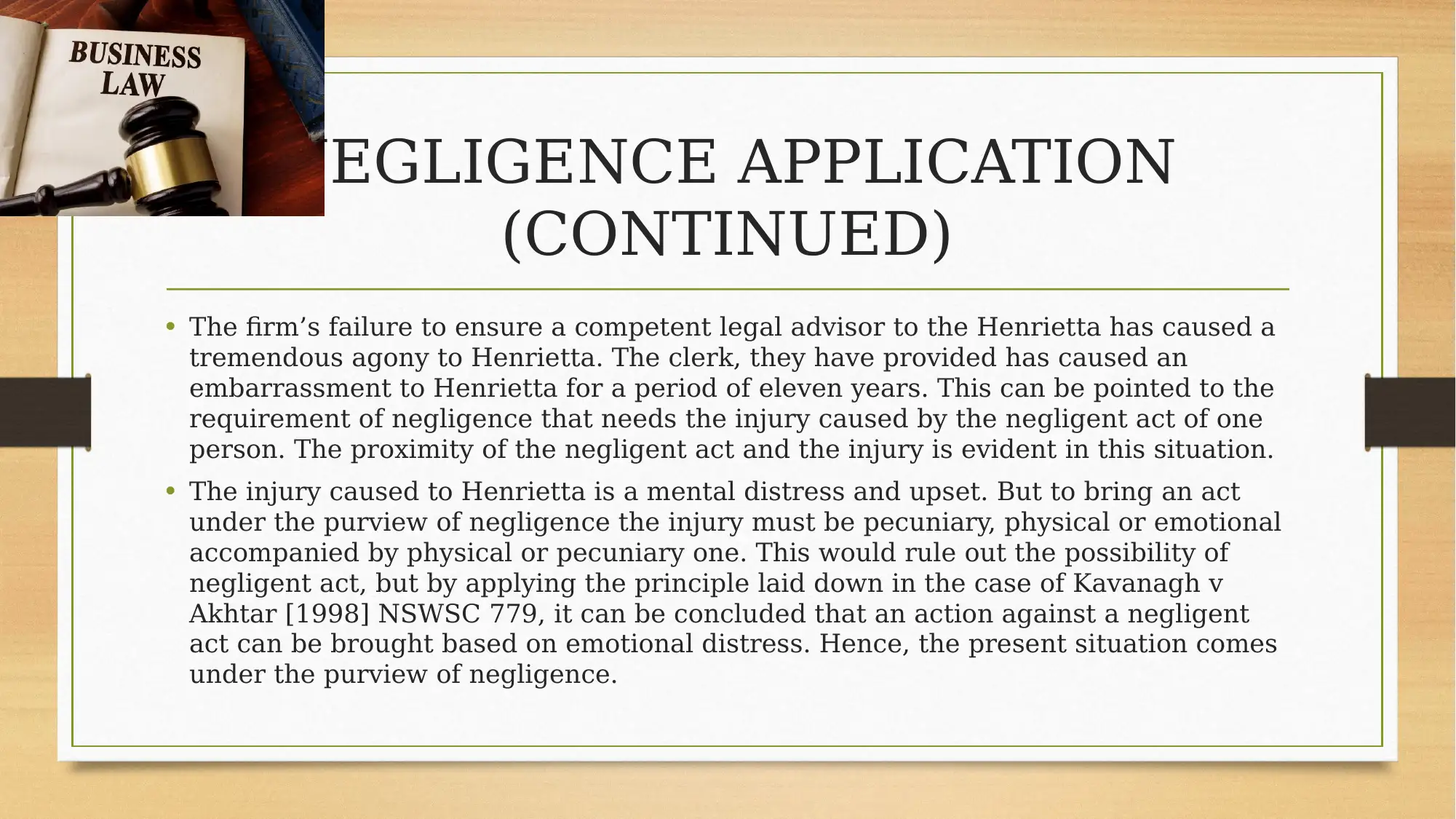
NEGLIGENCE APPLICATION
(CONTINUED)
• The firm’s failure to ensure a competent legal advisor to the Henrietta has caused a
tremendous agony to Henrietta. The clerk, they have provided has caused an
embarrassment to Henrietta for a period of eleven years. This can be pointed to the
requirement of negligence that needs the injury caused by the negligent act of one
person. The proximity of the negligent act and the injury is evident in this situation.
• The injury caused to Henrietta is a mental distress and upset. But to bring an act
under the purview of negligence the injury must be pecuniary, physical or emotional
accompanied by physical or pecuniary one. This would rule out the possibility of
negligent act, but by applying the principle laid down in the case of Kavanagh v
Akhtar [1998] NSWSC 779, it can be concluded that an action against a negligent
act can be brought based on emotional distress. Hence, the present situation comes
under the purview of negligence.
(CONTINUED)
• The firm’s failure to ensure a competent legal advisor to the Henrietta has caused a
tremendous agony to Henrietta. The clerk, they have provided has caused an
embarrassment to Henrietta for a period of eleven years. This can be pointed to the
requirement of negligence that needs the injury caused by the negligent act of one
person. The proximity of the negligent act and the injury is evident in this situation.
• The injury caused to Henrietta is a mental distress and upset. But to bring an act
under the purview of negligence the injury must be pecuniary, physical or emotional
accompanied by physical or pecuniary one. This would rule out the possibility of
negligent act, but by applying the principle laid down in the case of Kavanagh v
Akhtar [1998] NSWSC 779, it can be concluded that an action against a negligent
act can be brought based on emotional distress. Hence, the present situation comes
under the purview of negligence.
Paraphrase This Document
Need a fresh take? Get an instant paraphrase of this document with our AI Paraphraser
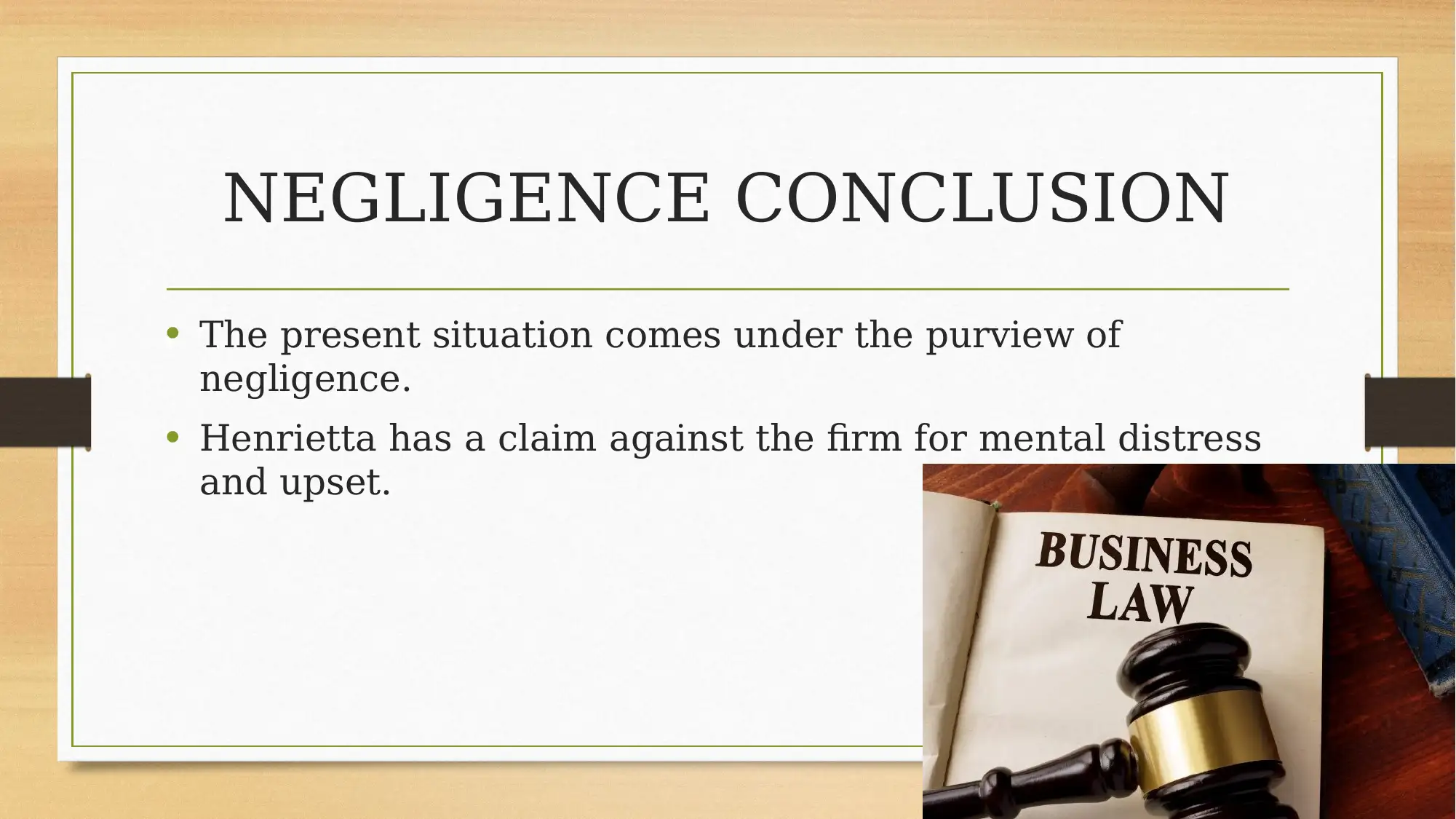
NEGLIGENCE CONCLUSION
• The present situation comes under the purview of
negligence.
• Henrietta has a claim against the firm for mental distress
and upset.
• The present situation comes under the purview of
negligence.
• Henrietta has a claim against the firm for mental distress
and upset.

⊘ This is a preview!⊘
Do you want full access?
Subscribe today to unlock all pages.

Trusted by 1+ million students worldwide
1 out of 12
Related Documents
Your All-in-One AI-Powered Toolkit for Academic Success.
+13062052269
info@desklib.com
Available 24*7 on WhatsApp / Email
![[object Object]](/_next/static/media/star-bottom.7253800d.svg)
Unlock your academic potential
Copyright © 2020–2025 A2Z Services. All Rights Reserved. Developed and managed by ZUCOL.





